Types of Arizona Spiders (With Pictures) – Identification Guide
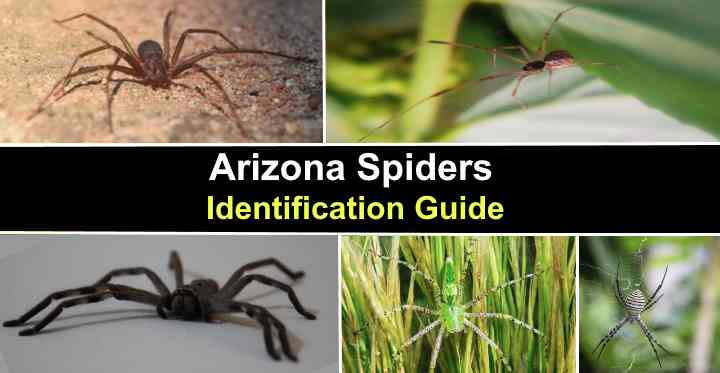
Arizona is home to a large number of spider species. From common brown house spiders to venomous black widows and intimidating wolf spiders, the Grand Canyon state has many different kinds of arachnids. Arizona spiders include the native Arizona brown spider, Arizona recluse, cellar spiders, and tarantulas. While all spiders can bite, two dangerous Arizona spider species are the brown recluse and the black widow.
Are you curious about what types of native and non-native spiders call Arizona home? If so, this article is for you. This guide to identifying types of Arizona spiders has descriptions and pictures of some of the most common eight-legged creatures you will find in the “sunset land.”
What are the Most Common Spiders in Arizona
Arizona is home to a diverse range of spider species. The most common and largest Arizona spiders are tarantulas, often found in arid desert environments. Common Arizona spiders you can find indoors include brown recluses, black widows, Southern house spiders, and wolf spiders.
Identifying spiders in Arizona is vital because some species can inflict a painful bite. For example, a bite from a small venomous brown recluse spider or black widow can result in fever, muscle pain, and nausea. However, hairy Arizona spiders like wolf spiders or tarantulas may look menacing, but their bites are usually harmless.
How to Identify Arizona Spiders
Spiders are eight-legged arthropods in the order Araneae. The easily identifiable features of spiders are their body shape and colors. Some Arizona spiders, like the Arizona brown spider and widow spiders, have bulbous, oval bodies and long spindly legs. In addition, spiders have six to eight eyes, a pair of chelicerae (jaws), and silk-spinning organs called spinnerets.
All spiders have bodies divided into two segments—a cephalothorax (a fused head and thorax) and an abdomen. However, unlike insects, spiders don’t have wings or antennae.
Besides seeing a spider scurrying across the floor, you can sometimes identify spiders by their web shape. For example, some Arizona spiders have messy, tangled webs, whereas others have irregular, loosely constructed webs. Additionally, many orb-weaver spiders construct eye-catching wheel-shaped webs.
Unless otherwise specified, all measurements of the spiders’ body size exclude the length of their legs.
Types of Spiders Found in Arizona (with Pictures) – Identification Guide
Let’s look in more detail at the types of Arizona spiders you might encounter. Pictures and descriptions will help to identify the most commonly found Arizona spiders, from tiny cellar spiders to large tarantulas.
Arizona Brown Spider (Loxosceles arizonica)

The Arizona brown spider vary in color but have a dark shape marking on its cephalothorax
The Arizona brown spider is a venomous species of recluse spider commonly found in the Grand Canyon State. Also called the desert brown spider, the small light to brown arachnid has a dark violin-shaped marking on its cephalothorax. The brown spider’s body measures 0.35” (9 mm) long, and its leg span is 1” (25 m).
Arizona brown recluse spiders are found throughout the southern United States. As their name suggests, the spiders tend to stay out of sight, lurking in crevices, dark places, closets, garages, and basements. Outdoors, you may come across them under piles of garden debris or hiding among stacked wood.
Arizona Spider Identification: The easily identifiable marking of the small Arizona brown spider is its dark violin-shaped marking on its cephalothorax.
Brown Recluse Spider (Loxosceles reclusa)
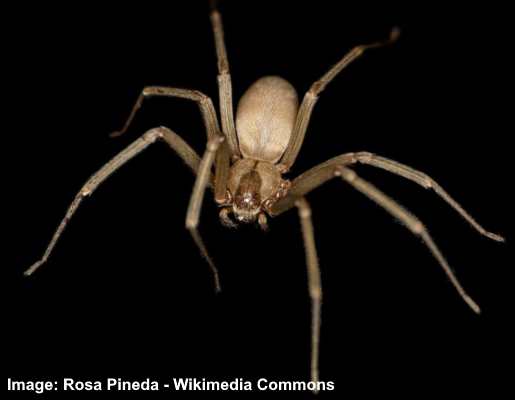
The brown recluse is a venomous spider with light brown body and long legs and is quite rare
The brown recluse spider is a small brown, biting spider you may encounter in Arizona. Identifying features of brown recluse spiders are the violin-like markings on their cephalothorax, pale brown or tan color, and six eyes. They measure 0.24” to 0.80” (6 – 20 mm) long.
It’s good to note that brown recluse spiders are relatively rare in Arizona. However, suppose you spot a small brown venomous recluse spider. In that case, it’s likely to be the native Arizona brown recluse or the desert recluse (Loxosceles deserta). Or it could be the common Southern house spider.
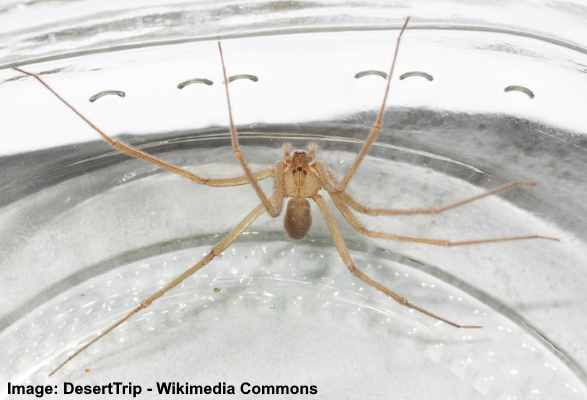
Desert recluse spider (Loxosceles deserta)
Due to their distinctive pattern, recluse spiders are also called violin spiders, brown fiddlers, or fiddleback spiders.
Arizona Spider Identification: The venomous brown recluse is a small light brown spider with a darker violin marking on its cephalothorax.
Southern House Spider (Kukulcania hibernalis)
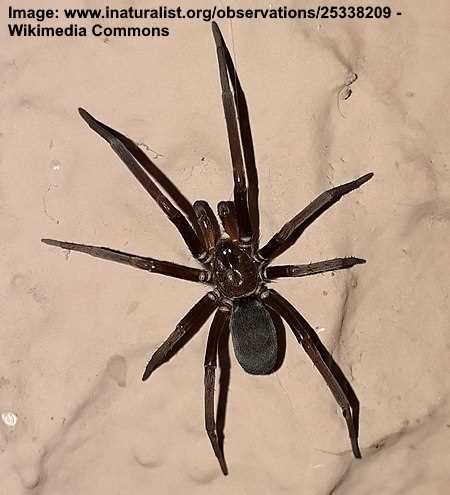
The southern house spider is identified by its dark brown color and its relatively large size
The southern house spider is a large brown spider with an oval body, spiny legs, and a violin-like mark on its cephalothorax. Commonly found in Arizona, the spider can measure 2” (50 mm) across, including its leg span. Other features of the spider are its spiny legs, oval head, and dark brown or black color.
Due to the violin pattern on the brown spider, it is easy to confuse it with the Arizona brown recluse. However, southern house spiders tend to be larger and stockier than small recluse spiders. The good news is that they are less venomous than brown recluse spiders.
Arizona Spider Identification: Identifying characteristics of the southern house spider are its dark brown body, violin pattern on its head, and large size.
Related reading: Types of spiders common in Florida.
Woodlouse Hunter (Dysdera crocata)

The reddish brown woodlouse spiders are usually found under logs but have also been found in houses
The woodlouse spider is an orange-brown spider with a chocolate-colored shiny abdomen and reddish legs. A distinctive feature of this brown spider is its prominent jaws that can give humans a nasty nip. Woodlouse spiders measure 0.4” to 0.6” (11 – 15 mm) long.
Like the related recluse spiders, woodlouse spiders have six eyes. The reddish-brown spiders are commonly found in Arizona under rocks, bricks, and logs. They also find their way into homes, searching for dark, cool hiding places.
Arizona Spider Identification: Identifiable features of the woodlouse spider are its large chelicerae, orange-brown or reddish body, chocolate-brown abdomen, and no distinguishing markings.
Arizona Black Hole Spider (Kukulcania arizonica)
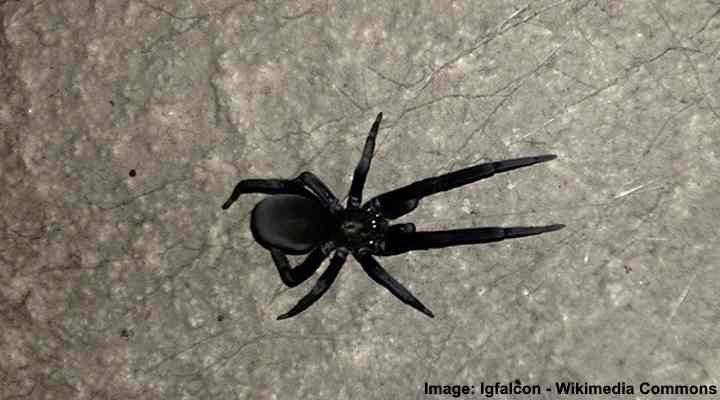
The body of the Arizona black hole spider is covered in fine hairs and it has two long front legs
The Arizona black hole spider is a dark brown or jet-black arachnid with two long front legs. The spider’s body is covered in fine hairs, giving it a velvety appearance. The medium-sized spiders measure 0.51” (13 mm) long. These black spiders can bite, causing localized swelling and pain.
Native to the Grand Canyon State, the Arizona black hole spider tends to live near human habitations in warm, dry climates. Therefore, you may find these hiding in cracks and crevices during the day before emerging at night to hunt for their prey. They feed on small insects, such as flies, cockroaches, and beetles.
Arizona Spider Identification: The Arizona black hole spider is identified by its dark brown or black color, light bands on its legs where they join the body, and flat webs to catch prey.
False Black Widow (Steatoda grossa)
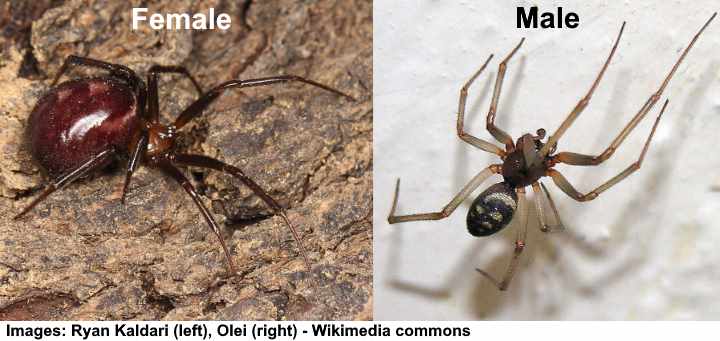
False black widow spiders: female (left) and male (right)
False black widow spiders are a species of common Arizona spiders. The females have a shiny chestnut-brown bulbous body and a small cephalothorax. Although it has the shape and size of a black widow, it lacks the distinctive red hourglass marking. However, its venomous bite can cause severe reactions, including pain, muscle cramps, and sweating.
There is great variation between female and male false black widow spiders. Males have a charcoal appearance, a slender oval abdomen with white markings, and grayish-brown translucent legs.
Also called the cupboard spider or false widow, this cobweb spider measures 0.24” to 0.41” (6 – 10.5 mm) in length. They are typically found in dark, dry places like basements, crawl spaces, and woodpiles. They spin messy cobwebs to catch their prey.
Arizona Spider Identification: The false black widow spider is identified by its shiny chestnut-brown body, legs, and head and light-colored markings on its abdomen.
Western Black Widow Spider (Latrodectus hesperus)
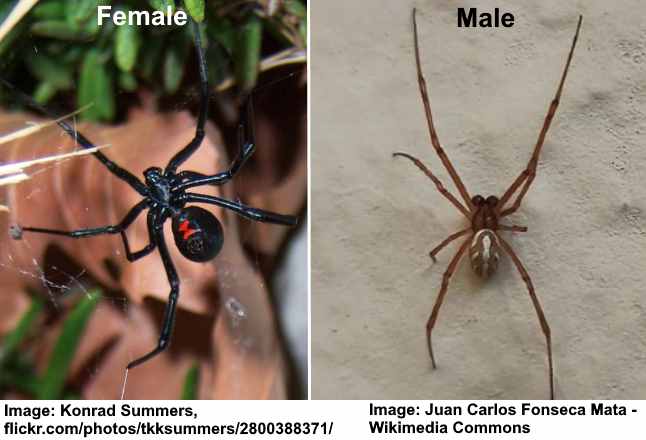
Western black widow spiders: female (left) and male (right)
The western black widow spider is native to Arizona and is one of the most venomous black spiders in the state. You can identify the shiny black spider by the red hourglass-shaped mark on its bulbous abdomen. However, the males look completely different, with slender brown-tan bodies and silvery markings.
Female black widows measure 0.55” to 0.63” (14 – 16 mm) and can be found across the state. They catch prey by spinning messy cobwebs, where they catch and feed on beetles, ants, and bees. You tend to find black spiders in dark places close to the ground.
Therefore, you should take care in Arizona working in the yard or cleaning under furniture to avoid getting a nasty bite from the venomous critters.
Arizona Spider Identification: The easily recognizable western black widow spider has a shiny black body, a red hourglass-shaped mark on its bulb-like abdomen, and spins a messy web.
Arizona Blond Tarantula (Aphonopelma chalcodes)
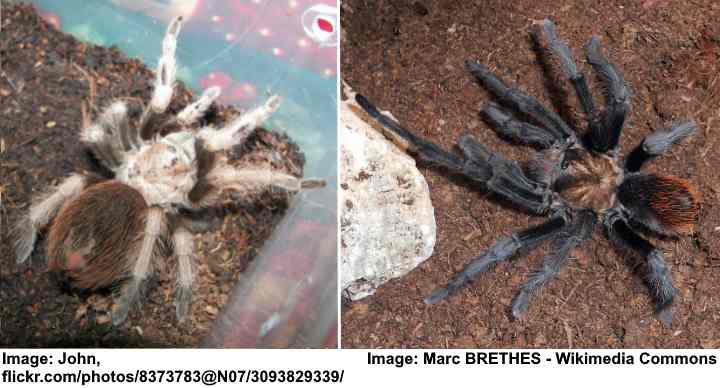
Arizona blond tarantula spiders: female (left) and male (right)
The Arizona blond tarantula is a creamy-white and brown tarantula with a hairy body. Also called the western desert tarantula, the huge burrowing spider has a long leg span measuring 3” to 5” (80 – 130 mm) across. Like most Arizona spiders, the males are smaller and look different. They are black with a reddish abdomen and copper-colored cephalothorax.
Native to the southwestern United States, these large hairy spiders create burrows in the ground. And, although they can bite, their bite is no worse than a bee’s sting. It is usually active at night when they leave their burrows to hunt small insects.
Arizona Spider Identification: Identifying features of the Arizona blond tarantula are its creamy-white to tan body, hairy appearance, and large size.
Wolf Spider (Alopecosa kochi)
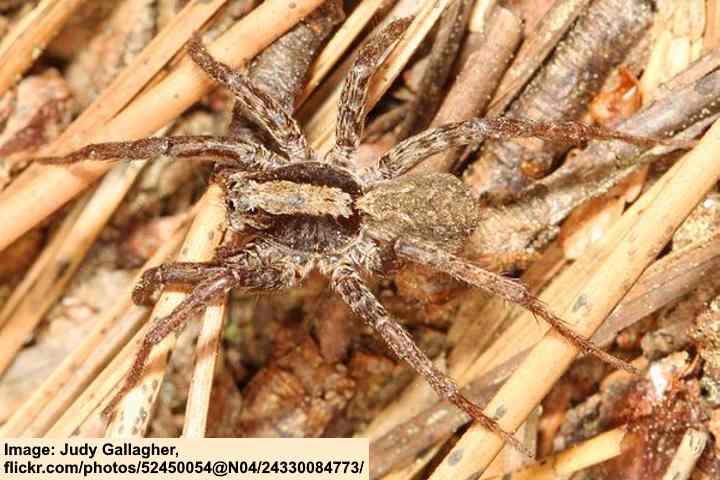
The wolf spider Alopecosa kochi has light and dark brown patterns on its body and can be usually found outdoors in Arizona
The Alopecosa kochi wolf spider is a large brown spider with mottled patterns on its body and stocky legs. Measuring up to 0.62” (16 mm) long, the hunting spider is most active in spring and generally stays outdoors in Arizona. It has eight eyes arranged in three rows, with two large eyes on the top row.
Wolf spiders are incredible hunters, able to easily catch their prey thanks to their excellent vision and speed. As a result, you can often see them scurrying across parched landscapes in Arizona.
Arizona Spider Identification: The Alopecosa kochi wolf spider is identified by dark brown cephalothorax with a light tan band in the middle, a light brown abdomen, and long, agile legs.
Carolina Wolf Spider (Hogna carolinensis)
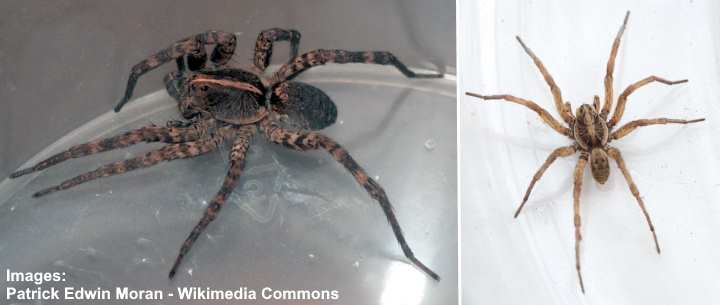
Carolina wolf spiders: female (left) and immature male (right)
The Carolina wolf spider is a large, hairy spider with distinctive black, dark brown, and tan markings. Common throughout Arizona, the female has a brownish-gray color, a tan stripe on its cephalothorax, banded legs, and a charcoal-gray abdomen. The furry female Carolina wolf spider is larger than the male and measures 2” (25 mm) long.
Compared to female Carolina wolf spiders, the males are significantly lighter in color. They tend to have a brown body with beige to pale tan legs.
Rather than spinning webs, the hunting spiders pursue their prey on the ground. Despite their intimidating appearance, Carolina wolf spiders are not venomous and are not considered a threat to humans.
Arizona Spider Identification: The Carolina wolf spider can be identified by its large cephalothorax and bulbous abdomen, brownish-gray color, and distinctive black and pinkish-brown striped legs.
Giant Crab Spider (Olios giganteus)
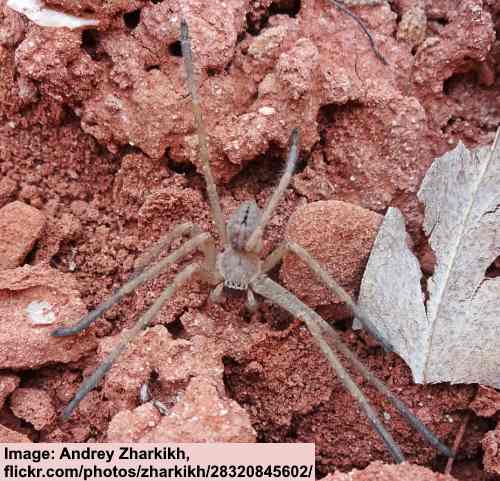
The giant crab spider varies in color but can be identified by its long fuzzy legs
The giant crab spider is a large, intimidating arachnid found in Arizona. This species of huntsman spider has a distinctive appearance with long, thin legs and a flat, crab-like appearance. The body is usually brown or gray, with a dark stripe on the abdomen. The legs are covered in fine hairs, giving them a fuzzy appearance.
A feature of this crab spider is its huge leg span of 3” (75 mm). Like many Arizona spiders, there are variations in their color, with some crab spiders being light tan with black chelicerae. Other large furry crab spiders can be almost black.
Despite their size, giant crab spiders are harmless to humans, and their bite only causes minor pain.
Arizona Spider Identification: The identifying features of the giant crab spider are its long legs that extend from its body at a 90° angle.
Western Spotted Orbweaver (Neoscona oaxacensis)

The western spotted orb-weaver has a distinctive black and white pattern on its bulbous abdomen
The western spotted orb-weaver is a large black and white spider with a bulbous abdomen. The spotted orb-weaver’s distinguishing features are its mottled blackish-gray pattern with a zig-zag band of white spots. The orb-weaver spider measures 0.35” to 0.70” (9 – 18 mm) in length.
Also called the zig-zag spider, the spider spins a classic spiral wheel-shaped orb web between plant branches in gardens.
Arizona Spider Identification: The western spotted orb-weaver is recognized by its distinctive white zig-zag markings spots on its grayish-black and banded, spiny legs.
Green Lynx Spider (Peucetia viridans)

The green lynx spider has elongated bright green body and creamy long legs covered in black dots
The green lynx spider is a bright green garden spider with long, spiny white legs and reddish spots on its body. Common in Arizona gardens, the green spider is identified by its slender lime-green tapering abdomen with six chevron marks. The pale creamy-yellowish legs are covered in black dots and spines.
Green lynx spiders grow 0.87” (22 mm) long, with the males half their size. However, the huge spiny legs make the spiders appear larger. The green spiders spin webs on shrubs but aggressively chase after insects. They are also known to make quick darting movements and jump large distances.
Arizona Spider Identification: The green lynx spider is identified by its bright green abdomen and cephalothorax, long translucent spiny legs, reddish V-shaped markings, and red spots on its body.
Grand Canyon Black Tarantula (Aphonopelma marxi)
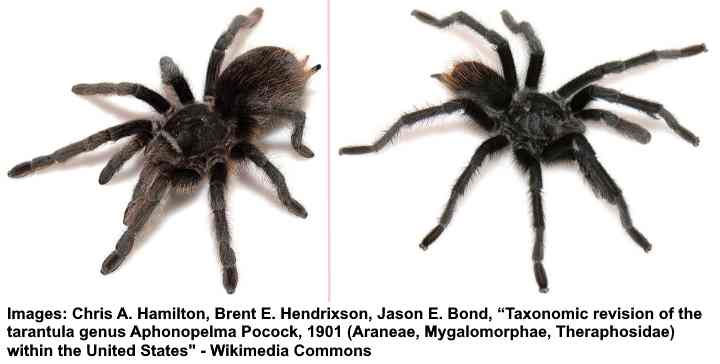
Grand canyon black tarantula spiders: female (left) and male (right)
The grand canyon black tarantula is a large, hairy, dark-colored spider native to Arizona and the southwestern United States. The female tarantulas are almost entirely black, while the males are dark brown with some orange or red markings on their abdomens. The females measure around 1.4” (35 mm) long.
The tarantulas are common in northern Arizona and create ground burrows. They feed on insects, small rodents, and other spiders. Despite their intimidating appearance, Grand Canyon black tarantulas are not aggressive toward humans. They will usually only bite if provoked or threatened.
Arizona Spider Identification: The Grand Canyon black tarantula is identified by its large bulbous body, stumpy legs, dark color, and short, black hair covering its body. There are also some orange or red hairs on its abdomen.
Phidippus Carneus
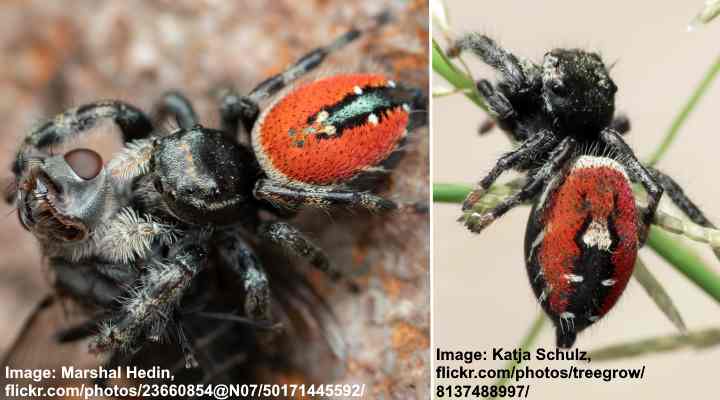
Phidippus Carneus catching a fly (left image)
The Phidippus carneus is a species of red and black jumping spiders with stunning colors. Its fuzzy abdomen is bright orange with a band of iridescent blue colors surrounded by black stripes and white dots. The small Arizona spider has a black head area with metallic blue chelicerae.
Phidippus carneus measures 0.60” to 0.67” (15 – 17 mm). The red and black jumping spider preys on insects such as flies, mosquitoes, roaches, and small grasshoppers.
Arizona Spider Identification: The Phidippus carneus spider is easily identified due to its bright red body, black markings, and superb jumping ability.
Western Parson Spider (Herpyllus propinquus)
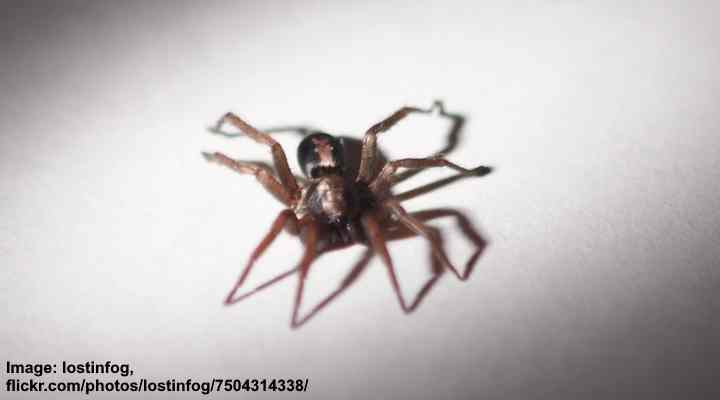
The western parson spider is identified by its tan or pale brown marking on its body
The western parson spider is a medium-sized black or dark brown spider with a distinctive pattern on its body. The spider’s name comes from the pale brown abdominal pattern that resembles an 18th-century parson’s cravat. It’s a small spider that grows around 0.33” (8.5 mm) long. The small spider hunts for prey rather than catching it in webs.
The western parson spider is commonly found in the western United States, particularly in grasslands and wooded areas. It sometimes gets into homes during cooler weather.
Arizona Spider Identification: The western parson spider is identified by its unique tan pattern on its black abdomen and dark brown legs.
Marbled Cellar Spider (Holocnemus pluchei)
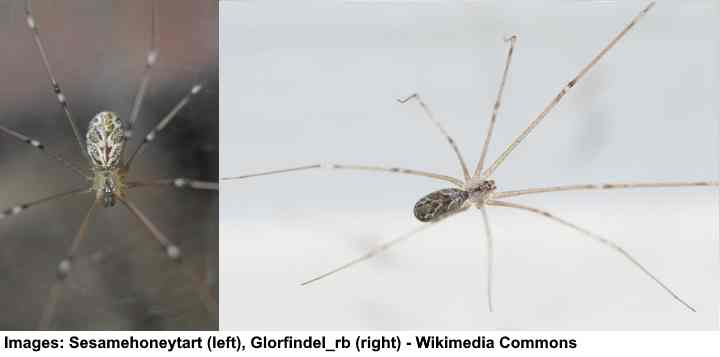
The marbled cellar spider has a small body with marbled patterns and very long and thin legs and is common in dark places in Arizona homes
The marbled cellar spider is a small, common household arachnid with a body length of only 0.20” to 0.31” (5 – 8 mm). The spider is easy to identify due to its long, thin legs and small body with creamy-white and brown marbling. The spider’s leg span is 2” (50 mm).
The marbled cellar spider is often found in cellars, basements, and other dark, damp places in Arizona and the western United States. Also called daddy long legs, the spider feeds on small insects. Although not dangerous to humans, it can become a pest due to the annoying webs it leaves behind.
Arizona Spider Identification: The marbled cellar spider is easily identifiable due to the marbling patterns on its small oval abdomen and long, thin legs.
Banded Garden Spider (Argiope trifasciata)

The banded garden spider: ventral and dorsal views
The banded garden spider is a large, striking spider with distinctive black, yellow, and white stripes on its abdomen. Other identifying features of this garden spider are its black and tan banded legs and intricate orb-shaped webs with a zig-zag pattern in the center.
The banded garden spider measures 0.60” to 0.78” (15 – 20 mm) long, and its legs can span up to 3.5” (90 mm) across. This spider is commonly found in gardens and fields across Arizona, sitting in a St. Andrew’s Cross shape in the middle of a large wheel-like web.
Arizona Spider Identification: The banded garden spider can be identified by its black and yellow banded pattern on its abdomen, round or oval-shaped body, and large size. The spider also builds large, circular webs with a distinctive zig-zag pattern in the center.
Related articles:
